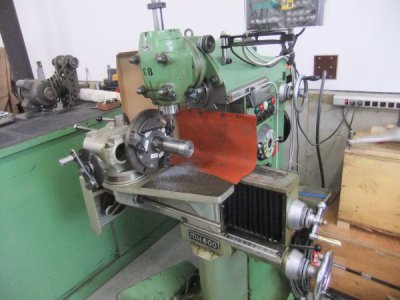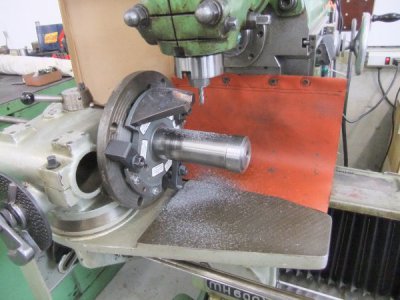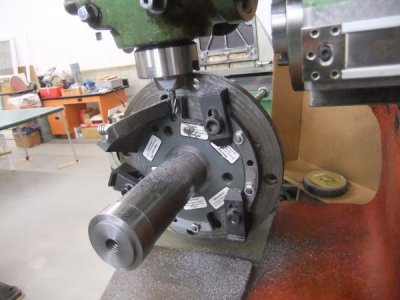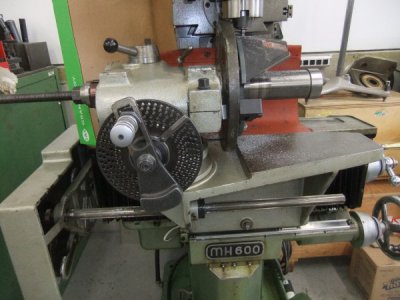That's the plan! Me and him got a deal worked out. For anyone wondering I got the machine for 300cad which works out to be just over 225usd. I only make like 1600 a month and rent is 1050 plus all my bills I really don't have alot of money to play with so he's been really good to me as far as pricing goes
-
Welcome back Guest! Did you know you can mentor other members here at H-M? If not, please check out our Relaunch of Hobby Machinist Mentoring Program!
You are using an out of date browser. It may not display this or other websites correctly.
You should upgrade or use an alternative browser.
You should upgrade or use an alternative browser.
Is This Possible On A Mill?
- Thread starter Izzy
- Start date
So I've been doing a little research on thread milling and I'm thinking this actually may be possible and for alot easier than I've been going about it. Still using a dividing head I found this setup it cuts 1.5mm threads with a little modification it could do 2.0mm threads
ive also seen people use a rotory table and electric motor and the part spins at a set rpm and table feed is set to a specific feed rate to cut the threads anyone heard of this or have more info on this? I have enough travel on all 3 axes to do this so I can position the part standing or laying down parallel or perpendicular to the table
- Joined
- Dec 8, 2013
- Messages
- 2,651
Here's a blue-sky approach: secure a 2mm nut inside the part, secure a piece of matching 2mm allthread horizonally above the table, and then drive the part onto the allthead so that it passes under the cutter in the spindle. You'll need a bushing secured to the table on each side of the cutter to stabilize the part and a handwheel of some sort on the part to turn it with (The table doesn't move, of course).
Last edited:
- Joined
- Feb 8, 2014
- Messages
- 11,176
...........ive also seen people use a rotory table and electric motor and the part spins at a set rpm and table feed is set to a specific feed rate to cut the threads anyone heard of this or have more info on this?
That's what I was talking about above, it's called electronic gearing. There a few ways to do it, but the easiest and cheapest way to do it today is to use stepper motors and just drive it with Mach3. This also gives you the option of cutting any thread you want just by changing a couple of numbers.
- Joined
- Feb 8, 2014
- Messages
- 11,176
Mach3 is probably the most common CNC software used by hobbyists, 10's of thousands of users.
That, a computer, and a kit like this is about all you need
http://www.ebay.com/itm/USAFREE-2Ax...073160?hash=item4af7914708:g:E4IAAOSwCypWnd0Q
That, a computer, and a kit like this is about all you need
http://www.ebay.com/itm/USAFREE-2Ax...073160?hash=item4af7914708:g:E4IAAOSwCypWnd0Q
- Joined
- Feb 8, 2014
- Messages
- 11,176
Well, kinda  What I am suggesting above is more of a partial CNC for one specific task. It just replaces gears or chains & sprockets. A full on CNC is not a bad idea.
What I am suggesting above is more of a partial CNC for one specific task. It just replaces gears or chains & sprockets. A full on CNC is not a bad idea.
Yes you could add control to the knee, but the more common method is to add it to the quill. But having a powered knee sure saves a lot of cranking. I love mine. Mine is only powered, but not under computer control.
Yes you could add control to the knee, but the more common method is to add it to the quill. But having a powered knee sure saves a lot of cranking. I love mine. Mine is only powered, but not under computer control.
- Joined
- Sep 25, 2014
- Messages
- 1,152
Wow, fascinating thread. What you are wanting to do is sometimes referred to as spiral, or helical, milling. As others have pointed out, 4 axis CNC provides a way of performing this – “thread milling” – which I have never done. With such a long component, it may present a challenge with tool overhang.
The picture you showed and much of the discussion is around conventional, manual spiral milling – which I have done, once. That is quite a fine thread to attempt by mechanical thread milling. For example the coarsest “thread” I would be able to mill is 8 tpi – using the standard gear set for my machine. The coarser of the threads you are looking at is between 12 & 13 tpi. I appreciate that what you want is a metric thread, but that can be converted using a 127 tooth gear (and add to the gear set to go beyond what it was intended for). There are probably numerous ways that the different manufacturer’s have configured their offerings – on my machine the short lead selections (less than 3” lead in one turn), is that the dividing head is turned by hand, which feeds back through the end gears to move the table. For longer leads (greater than 3”) the table is fed (hand or power) and the dividing head get turned by the gearing from the lead screw.
I get it that you have the opportunity to purchase all sorts of tooling for that mill you have, and you should seriously buy as much as you can afford. However, I would caution you against getting set up for spiral milling. There are many other milling machine operations that would typically be more common / useful than setting up for spiral milling. Typically spiral milling jobs would be “once in a blue moon”. Since you indicated you are tight on cash, I suggest you share what tooling you have the opportunity to purchase and a list of jobs you hope to undertake and the people in this community would be glad to recommend what would generally build that mill into a widely versatile machine.
As you said in your first post (and numerous others have agreed) – what you want to do, would be way easier on a lathe. You said you had seen lathe(s) in your area starting at about $2000 (and you would need to add some for tooling, depending on what it came with) would be less expensive than most of what you have been considering to make that part with out a lathe. The people who have replied that what you want to do is “possible” are correct. I agree it is possible, but wow. Certainly it would depend on what opportunities you are able to track down – buy cheap, fix, repurpose etc. However, if you are going from scratch that is a serious undertaking. One consideration I have not seen anyone share is that you could use your mill to make a “lathe like” machine. More like a threading bench than a lathe. Perhaps a thread chasing set up instead of end gears, lead screw etc.
I have never seen any active machining set ups (i.e. home hobby shops) with just a milling machine. I have seen numerous with just a lathe and various small support machines – that works well (that is all I had for many years). Perhaps others here could comment on the versatility of mill only work shops?
Attached are pictures of my one spiral milling job, recutting the ramps on a Reeves drive (mechanical variable speed pulley).
Let us know how you make out?




The picture you showed and much of the discussion is around conventional, manual spiral milling – which I have done, once. That is quite a fine thread to attempt by mechanical thread milling. For example the coarsest “thread” I would be able to mill is 8 tpi – using the standard gear set for my machine. The coarser of the threads you are looking at is between 12 & 13 tpi. I appreciate that what you want is a metric thread, but that can be converted using a 127 tooth gear (and add to the gear set to go beyond what it was intended for). There are probably numerous ways that the different manufacturer’s have configured their offerings – on my machine the short lead selections (less than 3” lead in one turn), is that the dividing head is turned by hand, which feeds back through the end gears to move the table. For longer leads (greater than 3”) the table is fed (hand or power) and the dividing head get turned by the gearing from the lead screw.
I get it that you have the opportunity to purchase all sorts of tooling for that mill you have, and you should seriously buy as much as you can afford. However, I would caution you against getting set up for spiral milling. There are many other milling machine operations that would typically be more common / useful than setting up for spiral milling. Typically spiral milling jobs would be “once in a blue moon”. Since you indicated you are tight on cash, I suggest you share what tooling you have the opportunity to purchase and a list of jobs you hope to undertake and the people in this community would be glad to recommend what would generally build that mill into a widely versatile machine.
As you said in your first post (and numerous others have agreed) – what you want to do, would be way easier on a lathe. You said you had seen lathe(s) in your area starting at about $2000 (and you would need to add some for tooling, depending on what it came with) would be less expensive than most of what you have been considering to make that part with out a lathe. The people who have replied that what you want to do is “possible” are correct. I agree it is possible, but wow. Certainly it would depend on what opportunities you are able to track down – buy cheap, fix, repurpose etc. However, if you are going from scratch that is a serious undertaking. One consideration I have not seen anyone share is that you could use your mill to make a “lathe like” machine. More like a threading bench than a lathe. Perhaps a thread chasing set up instead of end gears, lead screw etc.
I have never seen any active machining set ups (i.e. home hobby shops) with just a milling machine. I have seen numerous with just a lathe and various small support machines – that works well (that is all I had for many years). Perhaps others here could comment on the versatility of mill only work shops?
Attached are pictures of my one spiral milling job, recutting the ramps on a Reeves drive (mechanical variable speed pulley).
Let us know how you make out?




